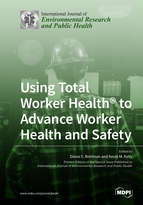Using Total Worker Health® to Advance Worker Health and Safety
A special issue of International Journal of Environmental Research and Public Health (ISSN 1660-4601). This special issue belongs to the section "Occupational Safety and Health".
Deadline for manuscript submissions: closed (31 January 2019) | Viewed by 165827
Special Issue Editors
Interests: neurotoxic effects and neurological disorders in humans exposed to chemical and other agents; impaired populations exposed to workplace hazards; adverse effects of pesticide exposure on neurobehavioral performance
Interests: biological anthropology; medical anthropology; total worker health; environmental health; occupational health; population health; mixed methods
Special Issues, Collections and Topics in MDPI journals
Special Issue Information
Dear Colleagues,
It is now recognized that aspects of the workplace (scheduling, shift work, physically-demanding work, chemical exposures), not only increase the risk of injury and illness, but also impact health behaviours (smoking, physical activity) and health outcomes (sleep disorders and fatigue, obesity, musculoskeletal disorders). In turn, ill health and chronic conditions can affect performance at work, increasing risk for injury, absenteeism, and reduced productivity. In the past few decades, programs that expand the traditional focus of occupational safety and health to consider non-traditional work-related sources of health and well-being have been shown to be more effective than programs that address these issues separately. This Total Worker Health approach has been recognized by the National Institute for Occupational Safety and Health as a method for protecting the safety and health of workers, while also advancing the overall well-being of these workers by addressing the conditions of work. This Special Issue is devoted to research “Advancing Worker Health and Safety” in the sense of Total Worker Health®. We welcome the submission of manuscripts presenting original basic and/or applied research relevant to program, policies or practices advancing holistic approaches to worker well-being. Themes may include, but are not limited to, the organization and design of the healthy physical and social work environments, innovative strategies for improving worker well-being, novel methods for exposing underlying occupational causes of chronic disease. The keywords listed below, as well as the issues identified in the text above, suggest some of the many relevant topics.
Dr. Diane Rohlman
Dr. Kevin M. Kelly
Guest Editors
Manuscript Submission Information
Manuscripts should be submitted online at www.mdpi.com by registering and logging in to this website. Once you are registered, click here to go to the submission form. Manuscripts can be submitted until the deadline. All submissions that pass pre-check are peer-reviewed. Accepted papers will be published continuously in the journal (as soon as accepted) and will be listed together on the special issue website. Research articles, review articles as well as short communications are invited. For planned papers, a title and short abstract (about 100 words) can be sent to the Editorial Office for announcement on this website.
Submitted manuscripts should not have been published previously, nor be under consideration for publication elsewhere (except conference proceedings papers). All manuscripts are thoroughly refereed through a single-blind peer-review process. A guide for authors and other relevant information for submission of manuscripts is available on the Instructions for Authors page. International Journal of Environmental Research and Public Health is an international peer-reviewed open access monthly journal published by MDPI.
Please visit the Instructions for Authors page before submitting a manuscript. The Article Processing Charge (APC) for publication in this open access journal is 2500 CHF (Swiss Francs). Submitted papers should be well formatted and use good English. Authors may use MDPI's English editing service prior to publication or during author revisions.
Keywords
- Work design
- Workforce demographics
- Work organization
- Work stress
- Globalization
- Safety and stress
- Precarious work
- Work-life continuum
- Human factors







